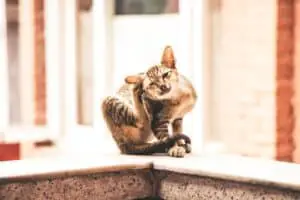
Cats are very demanding in the cleanliness and care of their coat, but sometimes they can overdo it. In this article we find out why cats pull their hair and what to do to avoid it.
Felines are very keen on looking after their furry coat, but sometimes they go overboard by shedding an excessive amount of hair. As a result, the animal may have a mottled coat, with spots without fluff.
In this article we will try to understand what are the causes that lead to the cat to tear its hair and what possible countermeasures to adopt to prevent it from happening, even if in serious situations it may become necessary to resort to specific medical treatments.
Why does the cat tear its hair? The possible causes
To prevent the cat from tearing its hair, it is first of all necessary to understand the underlying problem that leads it to this action and unfortunately it is not always easy and obvious to identify the precise cause.
The reasons that lead the feline to remove their hair can in fact be many and of different nature: they range from internal infections, to allergies due to something present in the environment, to move on to more or less serious health problems.
Let’s see them together.
Allergies in the environment
The environment in which the cat lives is full of allergenic substances, which can sometimes cause violent skin actions if your pet is particularly sensitive.
When we humans have an allergy, we usually experience eye pain, runny nose, and sneeze frequently. Felines, on the other hand, react differently and most of the time they manifest the allergy with itching, consequently they continue to scratch and lick their fur.
The main allergens that can be found in the home are cleaning products, dust, cow, mites and cigarette smoke.
But there are also other substances that can irritate the cat, with skin itching, such as spray deodorants, perfumes or hairspray when used near the animal.
As in the case of humans, it is often difficult to accurately determine the exact origin of an allergy and in most cases it is necessary to have a specialist test done on the animal. Obviously, once the answer on the cause of the allergy has been found, the element that generates it must be eliminated from the cat’s environment.
Infections and parasites
The poor cat can have infections or host, in spite of itself, internal and / or external parasites. Here are the main ones:
- ringworm: this disease is caused by a fungus that is usually seen on the back and head and presents with lesions. Kitty, bothered by the itch, will be led to tear the hair
- scabies: it manifests itself with lesions, dots and small scabs on the ears or on the body
- fleas: they cause the cat great itching, with loss of hair, erythema and even the risk of bleeding. It is advisable to apply an anti-flea immediately and in general it is important to check the cat regularly, throughout the year, to avoid fleas and worms. It is also necessary to eliminate parasites from the environment with specific products so as not to infest chairs, cushions and other parts of the furniture.
Food allergy
It is also necessary to consider the hypothesis that the cat has a food allergy, a common cause of skin problems that can lead to continuous licking or scratching and the consequent need to pull the hair. This is most often due to a particular protein present in the food and the diagnosis is made by placing Kitten on a hypoallergenic diet.
By changing the diet and eliminating the allergen, the cat can definitively recover, with the disappearance of the itching symptoms.
Stress, depression or boredom
The cat can also suffer from behavioral problems: when they take excessive care of their coat, their body releases endorphins, a natural form of morphine. Cat feels good and feels the need to clean himself continuously because he takes pleasure in doing it. It is a sort of anti-stress, for that in periods of strong stress or particular sadness it is easier for him to clean himself obsessively, to the point of pulling the hair off.
This attitude can appear in the cat following a trauma, such as the loss of a loved one, a move or a period of prolonged loneliness. Even the boredom of being alone can be the motivation for this behavioral reflex: in these cases it is better to be more present at home, to play with him and dedicate time and special attention to him in these moments of need and weakness.
It is necessary to try to understand what is the reason and the source of stress for the cat to remove the problem and if it continues to tear its hair despite your proximity, it is better not to let too much time pass and ask for a medical consultation. Moreover, we should not underestimate the fact that the physical health of the animal is a significant indicator of its mental state.
Health problems
If a cat has hairless areas, it may be suffering from hormonal or immune problems and should be examined by a veterinarian. In fact, it could be one of the following pathologies:
- Feline alopecia
- Dermatitis
- Pregnancy
- Hyperthyroidism
- Hypothyroidism
- Cushing’s disease
The drug treatment

As mentioned in the course of the article, when you notice the cat’s continuous tendency to lick and tear its hair, it is advisable to subject it to a veterinary check: it is the surest way to identify the real and effective cause of the problem.
Your doctor may prescribe anti-inflammatory drug therapy in case of severe skin irritation, to decrease itching and prevent the situation from worsening further. Corticosteroids are quite inexpensive and usually effective: A medium-sized cat is given a 5 mg dose orally once a day, with or after meals, for 5-10 days (depending on the intensity of the itch), reduced to one tablet to be taken every other day during the spring season.
Better to interrupt the drug treatment during the winter. But be careful: these drugs can have side effects on cat, which must be analyzed well with the doctor so as not to cause other health problems for the animal. There is in fact the risk of a possible increase in thirst and appetite (resulting in weight gain), as well as a greater chance of developing diabetes mellitus (caused by sugar).
You may also need to use antibiotics if you have a skin infection: the skin may appear shiny or moist, with sticky discharge and an unpleasant odor in the affected area.
You can also try to soothe the discomfort by gently wetting the infected body part twice a day with a cotton ball dipped in a salt water solution. For the preparation it will be enough to dissolve a teaspoon of salt in half a liter of hot water previously boiled and dry the skin well, dabbing at the end of the operation.






